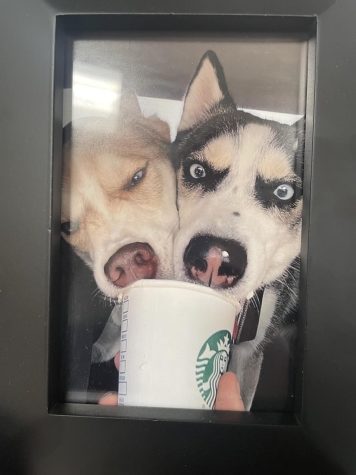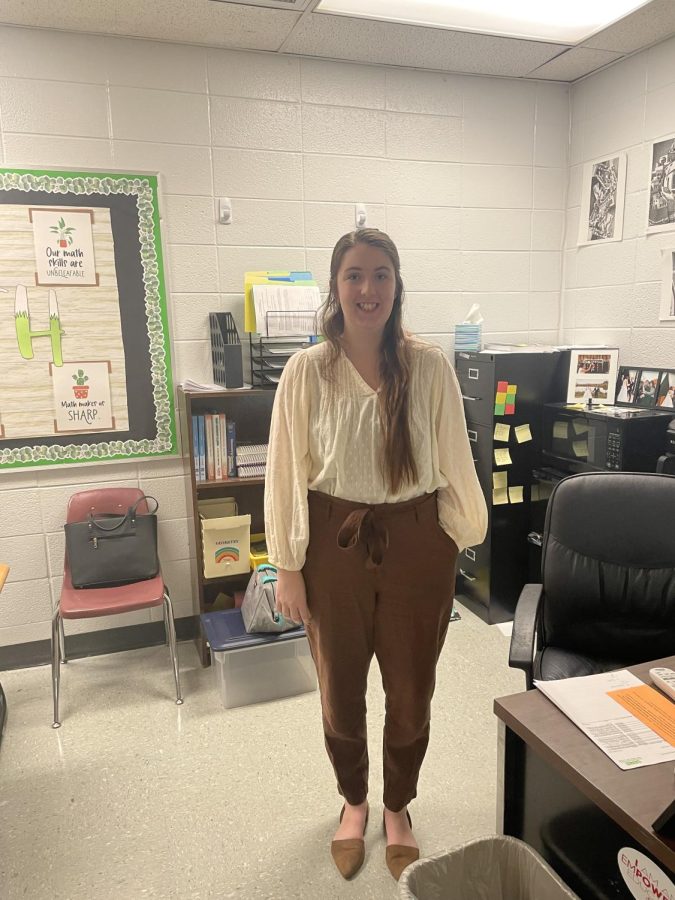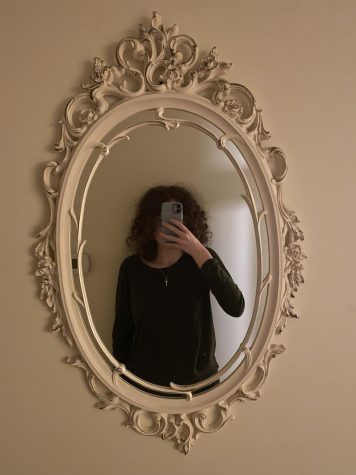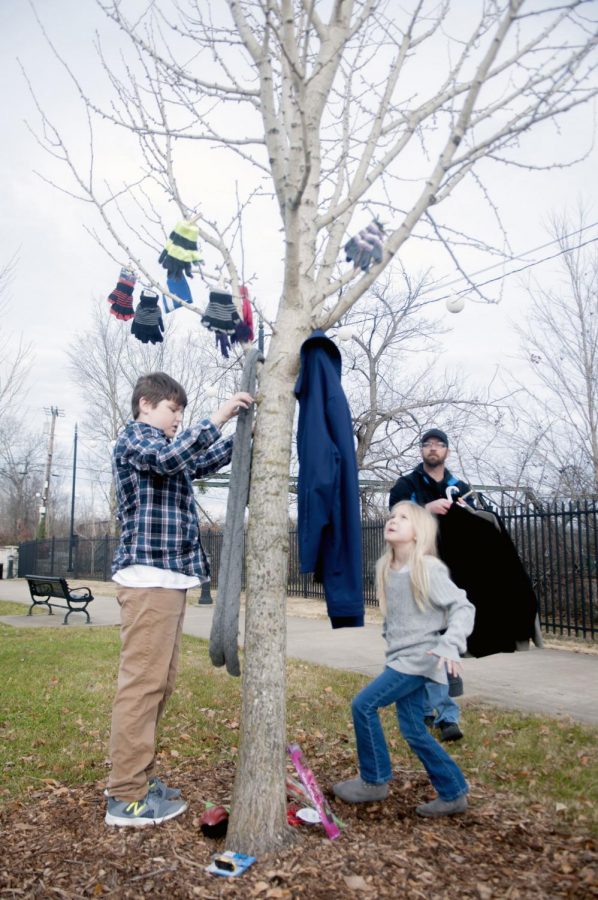A Chat With Mrs.Caldwell
February 11, 2022
Mr. Emerson’s old room is almost unrecognizable, and now belongs to Mrs. Caldwell. She is the new geometry teacher. The room is stuffy. Grey pencil drawings of geometric figures are plastered to a white cinderblock wall. If the drawings of geometric figures look familiar, it’s because they previously belonged to Mrs. Cato, who gifted them to the teacher who is filling the absence she left. The yellow desks with black chairs are in groups. A whiteboard has examples of perpendicular bisectors, rotations, translations, and dilations in red and blue marker. On the other wall, a poster board is filled with math and nature puns. One says “Math makes us sharp!” with a picture of an adorable cactus above it. A picture of two cute dogs sits on the teacher desk in the corner. Mrs. Caldwell has completely transformed the classroom for her first semester of teaching ever. Unlike most new teachers, Mrs. Caldwell arrived at the start of the second semester, not the first, as Mrs. Cato retired at the end of first semester.
Do you have any advice for students taking your class?
“My rule of thumb is that you get whatever grade you want to in this class because I allow test remakes, homework remakes, quiz remakes.” She also says “Be self-regulating about what you do and what you can do to improve, not only your schoolwork, but just yourself as a person. As long as you’re on top of things and communicate with your teachers, especially me; you’re gonna be a-ok.” She draws out “a-ok” to emphasize.
It’s your first year teaching. What’s that like?
“It’s,” Mrs. Caldwell paused, “different. I technically wasn’t supposed to start teaching this semester. I was supposed to be student teaching, which is something pre-service teachers (teachers who are studying to be teachers) do for free, kind of like a free internship. But because there’s such a teacher shortage right now I was allowed to long-term sub and get paid for it. I didn’t have that kind of mentorship training that a lot of people have, so it’s really good to get paid for this experience and getting to learn on the fly. But it’s definitely like being thrown into the water and your parents telling you ‘go swim.’ I’m liking it a lot so far,” She smiles. “But just like you guys, (students) I learn every single day about something new, and how to improve my teaching and improve myself through the day.”
What is the process of becoming a teacher like?
“It’s a little bit different for everybody, depending on what subject you teach. I teach math. Obviously, you have to go to college. I got a degree in mathematics and then I got a degree in education. The program I was in, my education degree is specific for math and science education, so I am certified just to teach eight through twelve grade mathematics. Every program you go to will be a four-year university program. Through those four years, just like most other majors, you will have to take a few board examinations. You have to go to elementary schools, middle schools, and high schools to observe other teachers, so you can learn from them. You do a whole lot of lesson planning, a whole lot of research into what really is education. Is this something you want to do? So it’s basically four years of running around to different schools, looking at different videos, and figuring out if this is really something you want to do. And if so, how can I learn from other teachers to become a teacher. So it’s very much a mentorship between your professors and other teachers, surrounding where you go to college.”
You said you have two degrees in math and education. Does that mean you double majored?
“Yes, so every program is different. Some teachers, like I, have a friend who only teaches elementary school: she only has one major, and it’s elementary school education. When you get up into high school and middle school, it’s more content-driven. When you remember back to elementary school, your one teacher who would teach you math, science, reading, and writing all throughout the day. When you get to middle school and high school, you have to have two degrees. One in education, that’s how we teach students, how do students learn, and one in whatever you want to teach, whether that’s history, English, or math. So it depends what grade you teach, how many majors you’re going to have in college.” She then adds that while it is a great deal of work; most programs have it laid out in a four-year curriculum, so that it can be finished in that time frame.
Why did you decide to teach at Greenwood?
“So, at first I didn’t want to be a teacher, I wanted to be a doctor. When I was growing up, I was really good at math and I was really good at science.” Mrs. Caldwell shakes her head for emphasis. “Failed chemistry in college. So doctor was out of the question really, really fast. And then it was kind of narrowing down what am I good at. And it was math. At first, I didn’t want to be a teacher; it was just something with math. And then I eventually added on the education degree and I really fell in love with it. Like I said this semester, I was supposed to be student teaching. When you do student teaching you get randomly assigned to a high school in your area, so I didn’t know what high school I was going to go to. Fortunately, Mr. Hatcher knew one of my professors, and he reached out to my professor, said they had an opening here, and they didn’t have any teachers to fill it. So they were looking at maybe getting a student teacher to fill it being a long-term sub, and my professor recommended me out of all my peers. I had an interview with Mr. Hatcher, and I was set up here. So like I said, it was supposed to be a randomly assigned, like free internship, but I had this really, really, really great opportunity here that I couldn’t turn down.”
What’s it like to go to college?
Mrs. Caldwell sighs, and runs a hand through her hair. “It’s really stressful. I’m not gonna lie to you. When I was in high school, I went to the Gatton Academy, so I didn’t finish my junior and senior year at my home high school in Somerset, Kentucky. I went to the Gatton Academy for two years. So before I went to college, I had a little bit of a college experience. Just from living in a dorm with a bunch of other high schoolers, so I kinda got the college experience class-wise, but not really socially. When I started ‘actual’ college or big kid college, it was definitely an adjustment. When you’re in high school, you have teachers on your Google Classroom telling you this is when this is due, this is an update, blah, blah, blah. When you go to college you get one piece of paper, it’s called a syllabus. It has all your due dates on it and then you go free. It’s a little bit different from high school. You don’t have any activities that your teacher does with you. You are solely responsible for your learning. That professor will lecture to you and if you’re confused it is up to you to. It took me a lot of self-regulation to realize what do I need help in and where do I get this help. That’s why I’m very, very, very, big with my students, if you need help please communicate with me because I don’t know if you need help or not.
Same with college. When I was in college, I struggled my first year or two because I didn’t want to ask for help. I didn’t know where to ask for help. So my college experience was a little different because at first I went to Gatton, and I was changing majors, and I was struggling, and I didn’t know where to get help. But after I started communicating with people and using my free resources on campus, it got better.” Mrs. Caldwell gives a self-deprecating laugh. “I kind of kick myself sometimes. Saying my college experience could have been better if I got help.” Her face lights up. “But besides that, I loved college. I think when you’re in high school, you have a lot of free reign over your education. When you’re in college you have complete freedom over what you take, when you take it. You still have some gen eds, but you can take classes for fun, you can kind of figure out if I really wanna do this. You can change your major and you can just go with the flow and figure it out.”
When would you recommend people decide on a major?
“My thing is when you are in college, college costs a lot, a lot, a lot of money.” She gives a grim smile. “There is something called an undecided major, so if you don’t know what you want to do, that’s completely fine. Your first year of college, go ahead and knock out those gen eds. Everybody has to take, I think….it’s twelve or thirteen classes that are gen eds throughout your college experience. Go in your first semester, take a few gen eds, maybe take one class you might be interested in, whether that’s math, an education class, a psychology class, sociology class.” She counts them off on her fingers. “Pick one class that you think is something that interests you. Take the rest gen eds. Maybe your second semester take more gen eds, and pick another class you think might interest you. That first year you can go undecided and just kind of figure it out while still working towards your degree by taking those general education classes. That’s what I would recommend for people, if you don’t know what you want to do, just because that way you’re not wasting any money. Like if your parents are paying for your college or if you’re taking out a loan, you’re not wasting any money because you’re still taking classes you have to take, but you still have a little bit of time to figure it out. I think there’s a lot of pressure on kids to figure out what they want to do with for the rest of your life at the age sixteen, seventeen, eighteen. So maybe take another year while you’re in college to figure it out. Do that gen ed thing. I really don’t think there is a completely right time to figure it out. But don’t go undecided all three years of college because you’re running out of gen eds and you’re just taking random classes. So I would say your sophomore year (is when you should pick a major).”
Can you tell me about your dogs?
“Oh my gosh. Wait a second.” Mrs. Caldwell reaches for the picture of two dogs on the desk.

A picture of Mrs.Caldwell’s dogs eating a puppuccino.
“I have two huskies. My black-and-white husky’s name is Nala. My tan-and-white husky’s name is Kia.” She puts the picture back. “We got Nala after we watched the Lion King movie with Beyonce. And we got Kia after we drove a Kia Soul rental car on mine and my husband’s honeymoon. Those are my first dogs. I’ve never had a dog before in my life. I got Nala when I was eighteen when me and my husband were dating. Both of our dogs have medical needs. I’m a sucker for dogs who have medical needs. Nala has a B-12 disorder. We found that out when she was a puppy. She wasn’t getting all her nutrients, so she’s like thirty pounds forever, and she’s like a mini husky. Kia’s the same way. We got her from the shelter right after we got married, right after our honeymoon. Someone had, unfortunately, abused her and broken her pelvic bone, so she will also always be tiny and not grow because of her bone deformities.” Her face falls. “But you would never know she ever got hurt. She jumps around the couch. She does parkour all the time.” Mrs.Caldwell smiles. “They’re crazy. But I love them so much. They’re my babies.” She presses her hand over her heart.
Did you pick huskies on purpose? Or was it just a random decision?
“My husband wanted a German Shepherd, so we were gonna just wait and look at our local Humane Society to see if a German Shepherd ever popped in. But then his parents’ friend’s….” She looks at the ceiling, trying to remember. “Somebody that his family knew had an accidental litter of huskies because they didn’t spay or neuter their dogs. So it wasn’t really accidental. But they said it was accidental. We went just to play with the dogs. And they had their dogs outside in the middle of July in Kentucky with no shade, nothing at all. These dogs were losing fur. Nala was probably six weeks old. It just broke my heart. And I said ‘Hey, can I take one of these dogs? This dog doesn’t look like it’s doing very well.’ And they were like ‘Yeah, we don’t care. Gimme like ten dollars.’ And I gave this person a ten dollar bill and went home with a dog that day. It was not planned whatsoever. But it just broke my heart to see all those dogs in that bad of a condition.” Her eyes are sad and she pauses for a movement to collect herself. Once she is composed again, she starts talking. “After our honeymoon, we decided we wanted another dog, so we went to the Human Society again. And there was Kia. Just sitting there, looking up at us.” She smiles. “They’re (Humane Society) people were like ‘Oh yeah! She’s a husky mix. We’re not sure if she’s full husky.’ I think she’s mixed with a corgi because she just looks funny. But we brought in Nala, and we had Kia and then another dog, and we were gonna see if Nala got along with either of them. Her and Nala just clicked. So it was coincidental. They’re like yin and yang, kind of. They match each other, really, really well.”
Interviewer: Thank you so much for letting me interview you!
Mrs. Caldwell loves teaching as much as she loves her dogs!



